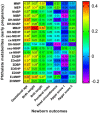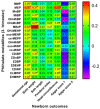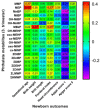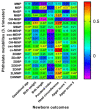Urinary Phthalate Biomarkers during Pregnancy, and Maternal Endocrine Parameters in Association with Anthropometric Parameters of Newborns
- PMID: 35327785
- PMCID: PMC8947339
- DOI: 10.3390/children9030413
Urinary Phthalate Biomarkers during Pregnancy, and Maternal Endocrine Parameters in Association with Anthropometric Parameters of Newborns
Abstract
Adverse birth outcomes present risk factors resulting in neonatal morbidity and mortality. Sufficient maternal hormonal concentrations are crucial for normal foetal development. Previous studies have shown a relationship between phthalate exposure and maternal hormonal levels during pregnancy. This study aims to investigate if neonatal anthropometric parameters are associated with maternal endocrine parameters during the ≤15th week of gestation and the third trimester of pregnancy concerning phthalate exposure in pregnant women from Nitra, Slovakia. We used high-performance liquid chromatography, tandem mass spectrometry (HPLC-MS/MS), and electro-chemiluminescence immunoassay to quantify urinary concentrations of phthalates and serum concentrations of hormones and sex hormone-binding globulin (SHBG), respectively. We observed a mostly positive correlation between neonatal anthropometric parameters (gestational age, birth length, birth weight, head circumference) and maternal concentration of phthalate metabolites (p ≤ 0.05). The hierarchical multivariate regression results showed a statistically significant association between Apgar score at 5 min after delivery, gestational age, birth weight, head circumference, and maternal endocrine parameters during pregnancy (p ≤ 0.05), adjusted to phthalate metabolites. To the best of our knowledge, our study is the first to indicate that prenatal exposure to phthalates may also affect birth outcomes through interaction with the maternal endocrine system.
Keywords: anthropometry; birth outcomes; maternal hormones; newborns; phthalate metabolites; prenatal exposure.
Conflict of interest statement
The authors declare no conflict of interest.
Figures






Similar articles
-
Effect of prenatal phthalate exposure on the association of maternal hormone levels during early pregnancy and reproductive markers in infants at the age of 3 months.Reprod Toxicol. 2021 Jun;102:35-42. doi: 10.1016/j.reprotox.2021.04.001. Epub 2021 Apr 7. Reprod Toxicol. 2021. PMID: 33838276
-
Prenatal Phthalates Exposure and Cord Thyroid Hormones: A Birth Cohort Study in Southern Taiwan.Int J Environ Res Public Health. 2021 Apr 19;18(8):4323. doi: 10.3390/ijerph18084323. Int J Environ Res Public Health. 2021. PMID: 33921744 Free PMC article.
-
Association between prenatal phthalate exposure and anthropometric measures of newborns in a sample of Iranian population.Environ Sci Pollut Res Int. 2021 Sep;28(36):50696-50706. doi: 10.1007/s11356-021-14182-0. Epub 2021 May 9. Environ Sci Pollut Res Int. 2021. PMID: 33966142
-
The Endocrine Disruption of Prenatal Phthalate Exposure in Mother and Offspring.Front Public Health. 2020 Aug 28;8:366. doi: 10.3389/fpubh.2020.00366. eCollection 2020. Front Public Health. 2020. PMID: 32984231 Free PMC article. Review.
-
Obstetrical outcomes and biomarkers to assess exposure to phthalates: A review.Environ Int. 2015 Oct;83:116-36. doi: 10.1016/j.envint.2015.06.003. Epub 2015 Jun 26. Environ Int. 2015. PMID: 26118330 Review.
Cited by
-
The Joint Effect of Perceived Psychosocial Stress and Phthalate Exposure on Hormonal Concentrations during the Early Stage of Pregnancy: A Cross-Sectional Study.Children (Basel). 2022 Oct 15;9(10):1561. doi: 10.3390/children9101561. Children (Basel). 2022. PMID: 36291497 Free PMC article.
-
Impact of prenatal phthalate exposure on newborn metabolome and infant neurodevelopment.Nat Commun. 2025 Apr 2;16(1):2539. doi: 10.1038/s41467-025-57273-z. Nat Commun. 2025. PMID: 40175358 Free PMC article.
-
Modulation of fetoplacental growth, development and reproductive function by endocrine disrupters.Front Endocrinol (Lausanne). 2023 Oct 3;14:1215353. doi: 10.3389/fendo.2023.1215353. eCollection 2023. Front Endocrinol (Lausanne). 2023. PMID: 37854189 Free PMC article. Review.
References
-
- Melmed S., Polonsky K.S., Larsen P.R., Kronenberg H. Williams Textbook of Endocrinology. Elsevier; Amsterdam, The Netherlands: 2015.
Grants and funding
LinkOut - more resources
Full Text Sources
Miscellaneous

